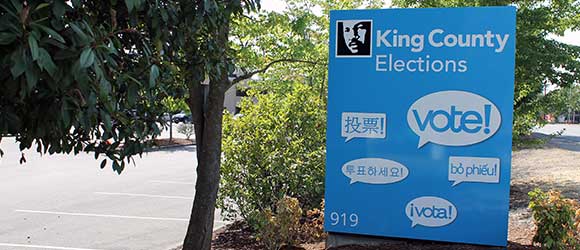Signature challenge data
In each election, the signature on your return envelope is compared to the signature on your voter registration record. A ballot is only counted if the signature matches the signature on your record.
About 1% of ballots go uncounted in each election because the voter’s signature is challenged or missing altogether. This data was compiled to guide King County Elections’ work in improving the signature challenge process for all voters. We are committed to removing barriers to voting and making sure every voter can make their voice heard.
Data Dashboard
The dashboard features data visualizations on signature challenges by age, race, language, and gender. A glossary of terms and more information on the data used to create this tool are below.
View data in full screen for the best experience. If using a mobile device, we recommend turning it sideways (landscape view).
Signature challenge maps
In this map you can explore:
- Ballot challenge rates by census tract (Nov. General 2020-2022)
- Ballot cure rates by census tract (Nov. General 2020-2022)
- Demographics of race and ethnicity from the 2020 Census
- Languages spoken from American Community Survey (2016-2020)
Resources
The signature challenge process can be hard to understand. Below are some terms that you will find regularly throughout the dashboard and map tools featured on this page.
Signature Challenge: For a ballot to be counted, state law requires a signature on the return envelope that matches a signature on the voter’s registration record. When a ballot is returned that is missing a signature on the return envelope or features one that does not match the voter’s record, it is considered “challenged” and is held uncounted until the issue is resolved by the voter.
A signature challenge is fixable and does not automatically mean the ballot is rejected. Learn more about how KCE reaches out to voters with signature challenges.
Cure: If the voter completes and returns the necessary form to KCE before the deadline, their signature challenge is considered “cured.” Ballots with a cured challenge are counted and added into the next results update.
Cure Failure: If the voter does not respond to their challenge or return the needed form, their ballot goes uncounted. This is considered a “cure failure” for the purposes of this data.
Certification: Elections and their results are made final and official by the King County Canvassing Board in the weeks following each election. The voter has until 4:30 p.m. the day before certification to resolve a signature challenge and have their ballot counted.
Certification Schedule:
Special elections – 10 days after Election Day
Primary elections – 14 days after Election Day
General elections – 21 days after Election Day
Signature Does Not Match: The signature on the return envelope does not match the signatures on the voter’s registration record.
Unsigned: The voter did not sign the required portion on the return envelope.
Age: Determined for this data set using date of birth from voter registration records.
Language and Language Spoken: The dashboard features language data from voter registration records. Registration records only reflect a language preference if the voter has submitted a voter registration form in that language or opted in to receive ballots and materials in that language. KCE currently provides ballots and all informational materials in Chinese, Korean, Spanish, and Vietnamese. While we do not currently provide materials in Somali and Russian, KCE hopes to add both languages in the coming year.
On the above maps, Language Spoken reflects data from the 2020 Census rather than voter registration records and includes a much broader list of spoken languages.
Race: ESRI Demographics and the 2020 Census are the sources of the racial composition data for these tools. Voter registration records do not include information about the voter’s race.
Gender: Determined for this data set using voter registration records.
Challenge Types: Shows the proportion of challenge type both overall and broken down by age, language, and gender.
Contact Elections
Email: elections@kingcounty.gov
Phone: 206-296-VOTE (8683)
TTY: Relay 711
Sign up for email or text notifications

 Translate
Translate
